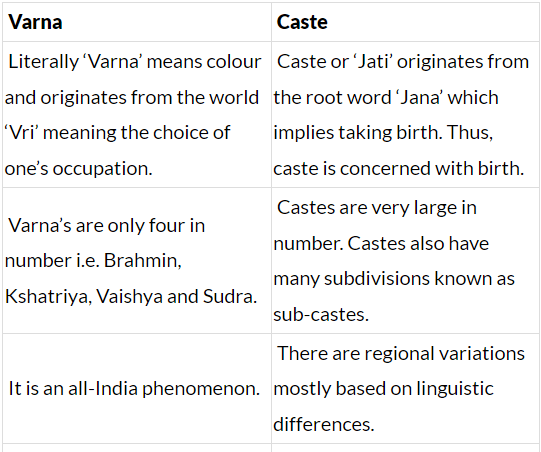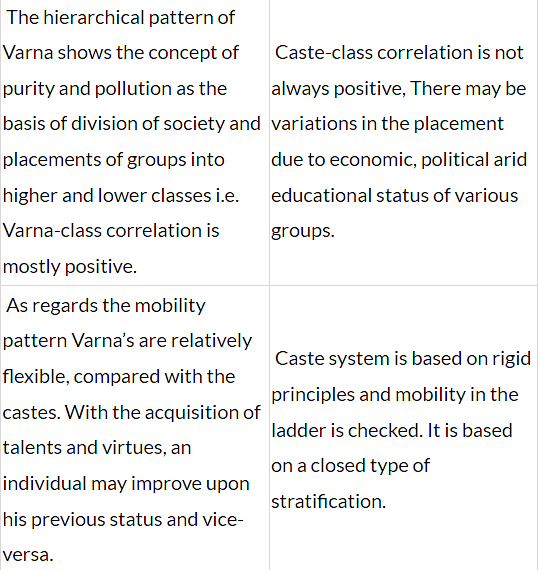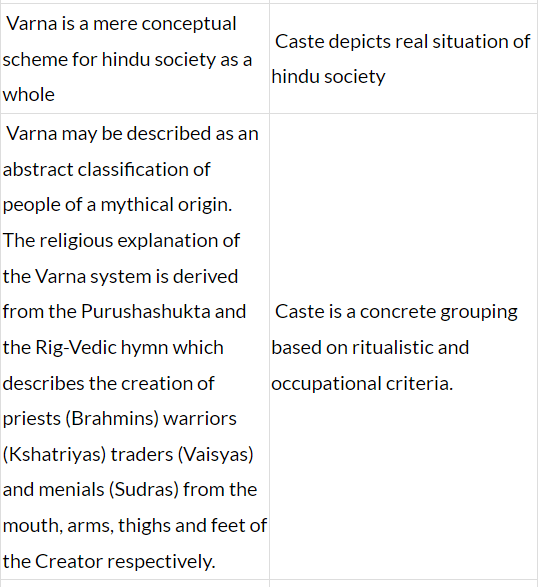Varnashram, Varna & Caste | Anthropology Optional for UPSC PDF Download
Introduction
Hindu society divided into two coordinated systems of social organisation.
- Whole human life divided into four stages ‘ashramas’ – Ashrama dharma to regulate individual’s social life
- Whole society divided into four strata-varnas
To organise and management of individual and society, these two schemes together called varnashrama vyavastha or varnashrama dharama.
Human life divided into four stage or Ashramas, Bhramacharya, grihastha, vanaprastha and sanyasa. Every stage has it’s own duties and functions . Each Ashrama is a stage of life. The individual performs duties and function of a ashram for a period to qualify for next ashrama . In his journey, he takes rest in each ashrama to prepare for future journey. Each individual should pass through four stages or phrases of life.
Concept
- Socio-religious institution of ancient India.
- It denotes Hindu scheme of life
- Different stages(ashramas) in the life
- In this scheme, theory of purusharthas get expression
- Ashrama scheme related to Varna system Which regulates individual’s social life
- The purusharthas are guiding principles for functioning of varnashrama dharma
Meaning of the word Ashrama
- Sanskrit word Ashrama denotes halting or resting place
- It also means stages, monastry, duties, etc..
- The word ashrama comes from sanskrit root ‘srama’ means making effort
- Ashrama means a step in the journey of life .
- According to Hindu ethics-final aim is liberation, or moksha
- Every Ashrama is a step in the long journey towards that aim.
Stages of Ashramas
- BHRAHMACHARYASHRAMA: The first stage or Ashrama. This stage is meant for knowledge, developing discipline, moulding character. The stage starts with initiation ceremony- upanayanam(conducting nearer) to bring the individual nearer to life purposes(purusharthas). It also brings nearer to teacher, guru. It marks second birth, Birth into a higher life. hey wear the sacred thread, yajnopavitha or dwija or twice-born
- Begining to education in Gurukula
- Begins educational career with teacher, “Guru” .
- The bhramachari (the pupil) to go to his guru who lives in forest hermitage
- He stays with for study and serves him
- He aquires knowledge of shashtras
- He leads life of simplicity and hard work.
- Development Of Personality and Character
- This stage is useful for development of character
- Character is moulded and given a shape
- His behaviour, thought patterns, attitudes channelised, prepared for the future
- He has to observe indriya samyama (control of senses)
- This helps learning process
- This stage transforms from animal like human child into a responsible person to meet challenges of life.
- Offering Gurudakshina And Receiving- Final Institution From Guru
- After end of student career, brahmacharian gives a present (gurudakshina)
- The guru gives final instruction
- The Teacher gives convocation address to the students
- First stage extends from 10 to 12 years
- Begining to education in Gurukula
- Grihasthashrama(Stage of Householder)– This stage is entered at marriage. After studentship, he is ready to take up duties of household life. In this stage, he get married, earns money and gets children. He pursues wealth (Artha) and pleasure (kama) within limits of mural law (Dharma). He earns money by honest means enjoy and distribute in a proper way. Marriage regarded as a sacrament.
- Importance of Grihasthashrama:
- It gives support to all other ashramas
- It helps householder to perform religious rites
- The individual fulfils his obligations towards society
- He gets children for the perpetuation of race
- He takes care of Bhramacharis, vanapras this and sanyasis who are not supposed to earn their living. He engages in all activities relating to varna.
- Importance of Grihasthashrama:
- Vanaprasthashrama (philosophic recluse) – After discharging all household obligations he enters vanaprastha stage. It consists of the third quarter of man’s life. After retiring from active life,he dedicates to a life of spirituality. After reaching age of fifty, it is regarded as age of satisfactions content and happiness. He has to hand over his authority and responsibilities to children. The inner call of vyragya(detachment) insists to give up all that is in his own.
- Importance of Vanaprasthashrama
- Avoidance of conflict between generations
- Mental Preparation for final journey
- Importance of Vanaprasthashrama
- Sanyasaashrama- It is a stage of total renunciation. In this stage a person becomes nameless and faceless. He has to preach truth, teach people and become detached absolutely. Anyone accepting Sanyas must entirely devote to Moksha aided by Dharma, with a complete renunciation of Artha and Kama. By pursuing path of knowledge, selflessness one can while living in society can pursue sanyas.
- Criticism of Sanyas Ashram
- Unproductive approach
- Wastage of knowledge and wisdom
- Women are not allowed to become sanyasi thus it was gender discriminatory in nature.
- Criticism of Sanyas Ashram
Composite model of Indian traditional social system
The four puruṣārthas are often discussed in the context of four ashrams or stages of life (Brahmacharya – student, Grihastha – householder, Vanaprastha – retirement and Sannyasa –renunciation).
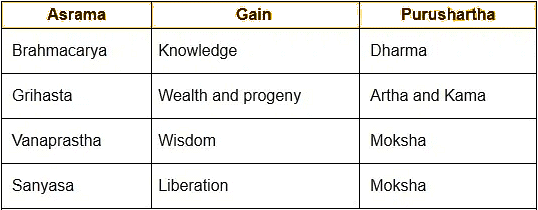
Scholars have attempted to connect the four stages to the four puruṣārthas, but neither ancient nor medieval texts of India state that any of the first three ashramas must devote itself predominantly to one specific goal of life.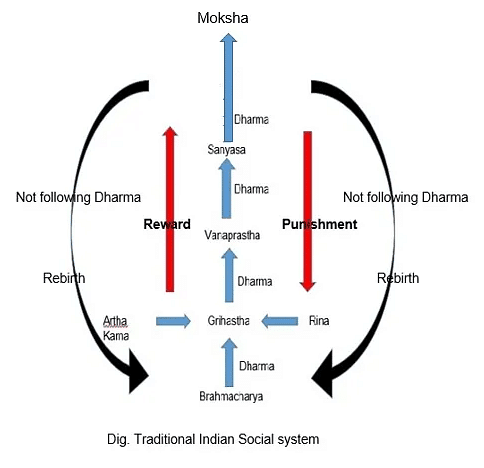
- The fourth stage of Sannyasa is different, and the overwhelming consensus in ancient and medieval Indian texts is that anyone accepting Sannyasa must entirely devote to Moksha aided by Dharma, with a complete renunciation of Artha and Kama.
- With the known exception of Kamasutra, most texts make no recommendation on the relative preference on Artha or Kama, that an individual must emphasize in what stage of life.
- The Kamasutra states,
The life span of a man is one hundred years. Dividing that time, he should attend to three aims of life in such a way that they support, rather than hinder each other. In his youth he should attend to profitable aims (artha) such as learning, in his prime to pleasure (kama), and in his old age to dharma and moksha.
Relevance
Past
- It gives meaning to the existence of man
- It gives purpose of life to many people
- It helps in proper maintenance of social order as well as law and order in society
Present
- It helps in proper maintenance of social order as well as law and order in society
- Reduction in crime rate
- Basis of ethical education in Indian society.
Factors of Change
- Modern philosophy
- Industrialization
- Technology
- Western education system
Conclusion
Balance in life between materialism and spirituality for peaceful, prosperous society and world.
Varna and Caste
Varna has its first mention in the rig veda. It mentions three varnas- brahma, kshatra, vaishya. There is no direct mention of sudras but references to groups despised by aryans like agoya, chandala, nishadas. It is said that their was no hierarchy in varnas during vedic period and it emerged during brahmanical period.
- Brahmanas: They are those, who seek knowledge for its own sake, be it the knowledge of God or the knowledge of the mundane. They are philosophers, academicians, teachers, authors, thinkers and also priests. They can be compared to the modern day education sector.
- Kshatriya: They are those, who are interested in politics, administration, and warfare. They include kings, politicians, warriors, soldiers, police, etc. They can be compared to modern day government and defence.
- Vaishyas: They are those, who are interested in commerce, businessmen, traders, profit seeker, producers, and suppliers. Modern day industrial and commerce sector.
- Shudras: Shudra etymologically means, one whose heart melts to the sorrow and pain of others. These are people who provide service- workers in factories, farmers, workers in BPO, medical, and other services, and even soldiers in the military.
Opler morris defines caste as -“caste is hereditary and endogamous. It regulates social intercourse, graded in rank and has an assembly which regulates internal affairs”. Ghurye refers to restrictions on feeding and social intercourse, civil and religious disabilities. It is the accepted that religious principles supporting caste system distinguishes it from other social stratification systems in the world. In India, caste system has two models is Varna model and Jati model.
Senate stated that caste and varna are not identical. Many anthropologists agree that caste is not a sub division of varna. As the origin of caste has nothing with origin of varna, though in the process of development of caste they came to be associated with varnas and the hierarchy and mobility of a caste came to be stated in varna terms.
Similarities
- Both are graded in rank is hierarchical in nature
- Both are realities of Indian social organization.
- Both allow mobilities though caste is more rigid than varna.
- Both are means of social stratification, means of occupation distribution and social system for creation of order in the society.
Differences Varna and Caste
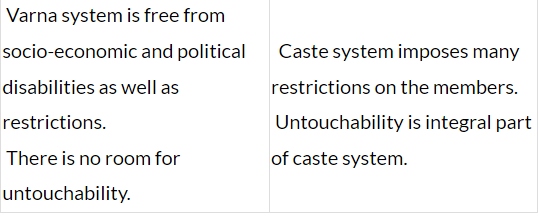 Though varna and jatis are different social organizational concepts, importance of varna is that it furnishes an all india frame into which jatis fit and had helped spread of uniform culture throughout the hindu society. At the same time varna model has led to misinterpretation of the realities of caste system.
Though varna and jatis are different social organizational concepts, importance of varna is that it furnishes an all india frame into which jatis fit and had helped spread of uniform culture throughout the hindu society. At the same time varna model has led to misinterpretation of the realities of caste system.Conclusion
- The concepts of Varna and Caste in Hindu society have played a significant role in shaping the social structure and cultural practices in India. While both Varna and Caste systems are means of social stratification and organization, they are inherently different in terms of origin, flexibility, and hierarchy. The Varna model, based on the four stages of life (Ashramas), has provided a framework for understanding and guiding individual's social and spiritual growth. The Caste system, on the other hand, has been more rigid and deeply ingrained in the social fabric, often leading to discrimination and social exclusion.
- Over time, both systems have undergone changes due to various factors such as modern philosophy, industrialization, technology, and the influence of western education system. While it is important to acknowledge the historical and cultural significance of these systems, it is also crucial to recognize and address the issues they have caused, particularly in the context of the Caste system. Striving for a more equitable and inclusive society, it is essential to find a balance between preserving cultural heritage and promoting social justice and equal opportunities for all.
|
209 videos|299 docs
|

